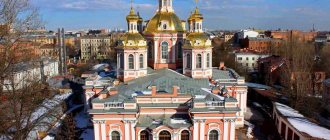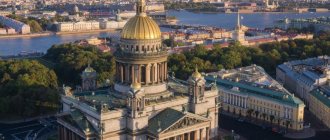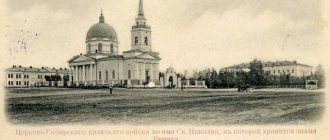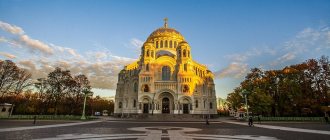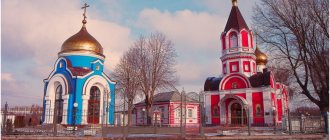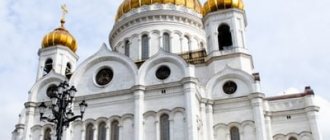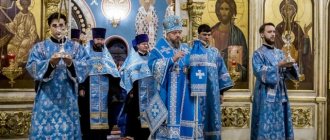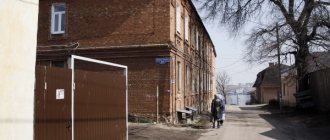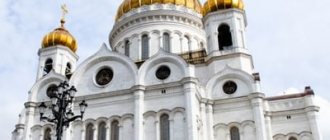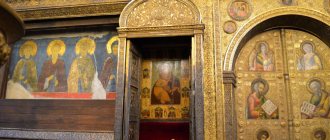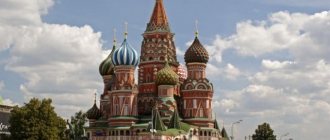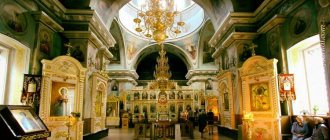Predecessor temples
In the first half of the 18th century, St. Petersburg was a very small city. On the site of modern Ligovsky Prospekt there was a road to Novgorod - the only road that connected the banks of the Neva with Russia. Families of coachmen lived next to the road, and gradually the Yamskaya Sloboda was formed here.
Orthodox Christians did not have their own church, so in 1710 they built a small chapel in the local cemetery. However, three years later the wooden building burned down in a fire.
The coachmen collected funds, drew up a petition, and in 1718, after permission from the archimandrite, they erected a small church in the churchyard in honor of the Nativity of John the Baptist. The one-story temple looked very modest. The elongated building had a high sloping roof and a narrow spire with a cross.
View of the Holy Cross Cathedral
After some time, a wooden belfry appeared nearby, but there were no bells for it. These were the years when, by order of Peter I, “extra” bells from Russian monasteries were brought to St. Petersburg and cannons were cast from them. The four bells were not given to the foundry workers, but were hung on the new bell tower.
In 1730 there was another fire. The raging fire burned the wooden temple to the ground. Devastated parishioners collected money and bought the old chapel at the Okhtinsky factories. So another wooden temple appeared on the ashes.
Unfortunately, his life was not long. The wooden building quickly fell into disrepair. After a few years, the walls became dilapidated and the roof began to leak when it rained. Distressed parishioners of Yamshchitskaya Sloboda drew up a new petition to the diocese and asked to be allowed to build a stone church.
Facade of the Holy Cross Cathedral
How to get there
Address: General Pavlov street, 2.
As already mentioned, the cathedral is located on an island, separated from the “mainland” by the Novaya Pregolya River from the north and the Staraya Pregolya River from the south.
Despite its monumentality, it is not so easy to see: the cathedral is hidden in the depths of residential areas, therefore, just walking around the city, you will not accidentally stumble upon it. The nearest stops with bus and minibus numbers are located approximately 800 meters from the cathedral on Oktyabrskaya Street and are shown on the map.
History of the cathedral in the 18th-19th centuries
The bureaucracy in Russia has been strong at all times. It took more than 15 years to obtain various approvals and collect the necessary funds. The construction itself took two years.
History has not preserved the name of the author of the project, but according to documents it is known that the workers were led by the German architect Johann Jacob Schumacher. He was an experienced architect who had already erected several civil buildings and churches in St. Petersburg. In 1749, the new temple was ready, and it was consecrated in honor of the Feast of the Exaltation of the Holy Cross.
In the 60s of the 18th century, the warm Church of the Tikhvin Icon of the Mother of God appeared nearby. It was built with the money of the merchant I. Ilyin.
At the beginning of the 19th century, architect Alexander Ivanovich Postnikov prepared a project for a high bell tower. By 1812, construction was completed. A four-tiered gate tower with a spire appeared in front of the two temples, and it immediately became the architectural dominant of the city.
Bell tower of the Cathedral of the Exaltation of the Cross
In the 1850s, the cathedral experienced a rebirth. The talented architect Yegor Ivanovich Dimmert completely rebuilt the building in the best neo-Baroque traditions. At the same time, he preserved part of the walls and foundation of the stone temple of the 18th century. The stucco work for the renovated cathedral was carried out by the skilled craftsman Timofey Dylev, and the icons were painted by the isographer Korotkov.
From 1856, for 18 years, the rector of the temple was the famous educator and teacher John Konstantinovich Yakhontov. Thanks to his efforts and the sponsorship of the merchant I. I. Shigalev, the Church of Cyril and Methodius appeared under the arches of the church bell tower. The architectural design for the small church was prepared by Ludwig Fedorovich Buglieri.
Year after year, St. Petersburg grew and expanded. The Ligovskaya side has not been a suburb for a long time, and the name “Yamskaya Sloboda” remains only in the memory of historians. Residents of Ligovka and Cossacks who performed military service in the city came to the temple to pray.
At the turn of the 19th-20th centuries, the cathedral parish was one of the largest in the diocese. It numbered more than 14 thousand people. At the temple there was a Society for Aid to the Poor, an almshouse for elderly women, a free canteen, a shelter for children and a parochial school.
Holy Cross Cathedral (St. Petersburg)
St. Petersburg, Ligovsky Prospekt, 128 (tel.: (812) 572-40-63), metro: “Ligovsky Prospekt”.https://krest-sobor.ru
The Cathedral of the Exaltation of the Cross has a long history, dating back to the first years of the existence of St. Petersburg. The coachmen, settled by Tsar Peter I in the new capital along the banks of the Ligovaya (in the old days, Black) River, did not have a church. At the request of the coachmen Vasily Fedotov, Peter Kusov and his comrades, by order of Archimandrite Theodosius, the Church of the Nativity of John the Baptist was built in 1718. A year later, it was consecrated by the abbot of the Alexander Nevsky Monastery, Hieromonk Varlaam. The temple was a small, elongated structure with a high roof, crowned with a spitz characteristic of Peter the Great's architecture. Initially there was no bell tower at the church. The wooden tiered bell tower was built in 1723. Four bells weighing 19 pounds were taken from the cannon yard. These bells were the kind that were brought from monasteries during the reign of Peter the Great to cast cannons from them. In 1730, the church burned down along with all its utensils. Meanwhile, next to it a cemetery had already been formed for residents of the Moscow side, founded by decree of Peter I, and therefore the temple was doubly necessary. In the same year, 1730, it was ordered to lay and build a church in the name of John the Baptist in the same place, with a chapel of St. Nicholas the Wonderworker. For this purpose, an old wooden church was purchased from the Okhta factories. Just two months later, on February 18, 1731, the church was transported and erected, and on February 25, the archpriest of the Cathedral of Peter and Paul consecrated it. The chapel of St. Nicholas the Wonderworker was ready only in November 1733. The temple, like the original one, was small. This church was located closest to the League Canal than later churches. It had a high roof topped with a small dome. Built out of “imminent need” from old materials and on a damp site, it did not last long. In 1740, the clergy and parishioners, informing the Synod that the church “now, due to its dilapidation, the roof is leaking very much, and the walls are dilapidated, and the service of the holy liturgies is being celebrated with considerable fear,” asked to be allowed to “in front of it, in front of the altar, to rebuild the holy stone church " Who was the author of the project for this new church remains unknown. The construction was supervised by the architect I. Schumacher. The parishioners and clergy wished to build a stone one instead of the dilapidated John the Baptist “in the name of the erection of the honorable and life-giving Cross of the Lord, since there are no holy churches with such a name in St. Petersburg,” and they intended to dedicate the chapels to the Nativity of John the Baptist and St. Nicholas the Wonderworker. Thus, the formerly two-throned church acquired a third throne. The main altar was consecrated by Archbishop Theodosius on June 24, 1794. The one-story stone temple was cold. In plan, it had the shape of a Latin cross with a rectangular projection of the apse in the eastern part and exactly the same, symmetrically located vestibule in the western part. There was a bell tower above the western porch of the church. With the construction and consecration of the stone, dilapidated wooden church “stood unused and was dismantled in 1756.” In 1764, the clergy and parishioners submitted a petition to build a new warm church in its place: “near one church on an empty site, where there was previously a stone wooden church of the Nativity of St. John the Baptist before the construction and was broken due to disrepair, to build again a stone warm one in the name of the Most Holy Tikhvin Church of the Mother of God, so that they could no longer bear the needs of the frost.” The Tikhvin Church was founded on June 20, 1764 behind the altar of the Holy Cross Church. In plan, the Tikhvin Church surprisingly resembled the Exaltation of the Cross of 1748: an elongated rectangle, a barely outlined expansion in the eastern part, 3 naves, the compartments of which are covered with cross vaults, one dome on an octagon, processed by pilasters. The name of the architect who built the Tikhvin Church is unknown. In the middle was the main altar in the name of the Tikhvin Icon of the Mother of God, on the right was a small chapel of St. John Chrysostom. The main chapel was consecrated on December 14, 1768. Other chapels were built much later - for early liturgies and for commemorating persons buried in the church. In 1804, the architect A.I. Postnikov made a design for the bell tower. The bell tower, which was completed in 1812, is connected by two semi-circular colonnades with chapels. Sculptures depicting the Apostles Peter and Paul are placed in deep niches. The bell tower is about 28 fathoms high (about 60 m). Its upper part is decorated with eight plaster images of the apostles, the lower part with four. Forged iron gratings by blacksmith Fyodor Martyanov were inserted into the spans in 1853. The ringing tier on the bell tower was the third, there were 12 bells. On the left, in the second floor of the lower tier of the bell tower, “at the expense of the church warden, merchant Ivan Shigalev, a small temple was built in the name of the Slavic enlighteners Cyril and Methodius. The design of this temple was carried out by the architect L. Buglieri in 1871. It was consecrated on February 2, 1878 by Metropolitan Isidore. A stone staircase led to this church, with 40 steps up to the second tier. Soon after the completion of the bell tower, parishioners and clergy faced the need for a new large expense: by the end of 1830, both churches - Holy Cross and Tikhvin - had become so dilapidated that they required major repairs. Having calculated “what it would cost to fix both churches,” the parishioners decided to build one new church instead of repairing two dilapidated churches. Architect V. Morgan drew up a design for the temple, which he executed “in Greek taste, in accordance with the style of the existing bell tower, with the goal of placing 2,500 pilgrims in it.” The temple was conceived on a grand scale. The clear resemblance to St. Isaac's Cathedral, which at that time was not yet a completed building, should have contributed to the creation of an impression of grandeur. But before the construction of the new temple began, it was necessary to expand the Tikhvin Church with an extension. This project was carried out by the same architect W. Morgan. The construction of the temporary extension lasted quite a long time. In June 1844, the Predtechensky and Nikolsky chapels were moved from the Exaltation of the Cross to the Tikhvin Church and were consecrated on the 24th. As a result of the extension, the church was surrounded by a stone rectangle so that on both sides it became wider by 4 fathoms (about 8.5 m), its length increased by the length of the porch, a sacristy and a guardhouse were added, and wide arches were formed in the longitudinal walls. The long existence of the church gave the clergy and parishioners a reason to ask, after the completion of the construction of the Exaltation of the Cross, for the preservation of the Tikhvin Church in its present form, without dismantling it. When the extension to the Tikhvin Church was completed in 1844, the question arose about the need to begin work on the construction of a new Church of the Exaltation of the Cross. But construction was delayed due to a lack of funds to implement Morgan's project, conceived on such a large scale. The construction commission and parishioners asked for permission to rebuild the church according to a new project by E. I. Dimmert, with the cancellation of the previous one approved in 1841. An examination of the church was carried out, showing the strength of the old structures. The author of the project for the reconstruction of the Church of the Exaltation of the Cross, architect Yegor Ivanovich Dimmert, was born in 1783, and in 1800 he entered the Academy of Arts. In 1807 and 1808 he was awarded silver medals. In 1809 he was released with a first degree certificate and a sword. He chose Konstantin Evgrafovich Lazarev, who graduated from the Academy of Arts in 1838, as his assistant. In April 1848, construction began at an astonishingly fast pace. The bulk of the work was completed in just six months. Built 1848–1851 includes part of the walls and pillars of a church from the 1740s. In 1851, work on interior decoration was in full swing and by December it was mostly completed. On the middle pillar under the altar of the temple the following inscription was placed: “In the 27th year of the reign of Emperor Nicholas I, this temple was consecrated in the name of the erection of the life-giving Cross of the Lord on December 2, 1851 by the Most Reverend Nikanor, Metropolitan of Novgorod and St. Petersburg.” On June 1, 1852, the chapel of the Nativity of St. John the Baptist, June 8 - St. Nicholas the Wonderworker. So, the work of building a new church, begun in 1840 by the clergy and parishioners, ended in 1853 with the construction of a church that beautified the Yamskaya Sloboda and, fortunately, has survived to this day. Of particular interest is the essay published in the “Historical Works” of Alexander Tomilin and dedicated to the Church of the Exaltation of the Cross. It was written in 1852, that is, the year the construction was completed, and an eyewitness to this construction, Tomilin is the only historian who accurately indicated which parts of the church of 1740 were included in the new building. He writes: “In 1848, the old Church of the Exaltation of the Cross was dismantled. What remains of the old building is part of the walls in the western section, which is elevated with the main entrance and covered with vaults, with a vestibule attached to it. The eastern section, where the altars are located, has been completely re-erected; The middle of the church, consecrated by five open domes, is also common. On the right and left sides there are 2 rows of pillars running from the entrance to half of the temple, and surrounded at the bottom with railings... Only part of the old foundation and the western section resemble a primitive building, although in general the temple appears in a completely new form.” The Church of the Exaltation of the Cross has the shape of a Latin cross in plan, with one semicircular asp. The building is stone on a stone foundation. The length of the church is about 53 meters, the width is about 35 meters, the height with the dome and cross is about 41 meters. The church is one-story, crowned with five domes with light drums. There were altars in the arms of the cross, as well as in all three naves; the temple had five altars. The main altar is dedicated to the erection of the Cross. To the right of it is the border in the name of the Nativity of John the Baptist, to the left is the chapel of St. Nicholas the Wonderworker. In the southern arm of the cross there is a chapel in the name of the holy Equal-to-the-Apostles kings Constantine and Helen. In the north - in the name of St. Sergius of Radonezh. On the vault of the large dome were images of the seven archangels, John the Baptist and cherubs. The church remained active until 1939, when it was closed, and in the 1940s the interior was distorted by redevelopment, the construction of new walls and ceilings. During the war, the church was damaged by artillery shells. And in 1947 it was transferred to the production needs of restoration workshops. Currently, the church has been returned to believers and operates in the status of a cathedral. The temple was transferred to the Orthodox parish, which united the St. Petersburg Cossacks. In 2002, a bust of Nicholas II was installed near the altar wall of the Holy Cross Cathedral.
The fate of the temple in the 20th century
After the revolution, the cathedral was not immediately closed. Divine services continued until the early 1930s, when mass persecution of believers began in the country. First, the city authorities liquidated the Tikhvin Church. The religious building was given over to a school. Then production workshops were created here, and part of the premises was given to the radio engineering college.
In 1938, it was the turn of the Holy Cross Church. During the repressions, eight priests were shot, and the cathedral was closed to parishioners for a long time. The building was converted into a film storage facility. New warehouse floors and cross beams significantly distorted the interiors and disfigured the temple.
Then the war began. During the artillery shelling of Leningrad, several shells hit the cathedral. However, this was not the only problem. In the first winter of the blockade, the bodies of Leningraders who died of hunger were brought to the temple. They were not buried because it was terrible cold. Only in the spring of 1942 did the dead residents of the city receive their last refuge at the Volkovsky cemetery.
After the war, restoration workshops were located in the cathedral. For several years, heavy woodworking machines and lathes stood inside. The floor was covered with a thick layer of asphalt, there was a bathhouse in the vestibule, and workers undressed in the altar.
Sculptures of the apostles Paul and Peter in the niches of the cathedral bell tower
In 1991, the ancient building was transferred to the Cossack parish of the city. According to the documents, the condition of the temple was assessed as “ruins”. It looked like a huge barn with half-collapsed plaster.
First, it was necessary to clear the area of debris and raise money for construction materials. The first service was held in 1993. Large-scale restoration of all church buildings took more than 10 years.
Architecture and decoration of the building
The building has original architecture. The cathedral was originally the property of the Lutheran Church, which was reflected in its appearance.
Appearance
The temple has an unusual shape: it is a Greek (equal-ended) cross. The building would have made a noticeably gloomy impression if there had not been a mosaic on the central façade with a huge image of a Protestant cross and an ornament with Bourbon lilies and compass roses.
The building is faced with decorative bricks.
If we talk about the architectural style, the building as a whole can be attributed to late modernism, with elements of neoclassicism. The cathedral has three aisles. Two towers of equal height rise above the western façade. The towers end with domes and are connected by a covered gallery. Before reconstruction, there was a clock under the gallery.
The main architectural element of the western facade can be considered an impressively sized niche-portal, whose surface is decorated with a Kadin majolica panel with a large cross.
The clergyman's house adjoins the eastern side of the church.
Interior decoration
The decoration of the temple was changed several times. Initially, the interior of the church was designed by the German artist Erchst Fey. The stained glass windows were made according to the sketches of another master, Gerhard Eisenbletter. Another Königsber artist, Jacob, was involved in the design of the altar lamp, the communion cup and the baptismal font. The side naves of the church were decorated with balconies. This decoration of the temple was destroyed by the war. However, more serious damage was caused as a result of its post-war operation and reconstruction of the building in the early fifties. During the reconstruction, new ceilings were installed in the temple and a third floor was built. They also changed the shape of the roof, now it looks more hollow. They also added a building for economic purposes.
When the church was transferred to the Orthodox community, the interior decoration was restored in accordance with the canons of the Orthodox Church.
The main attraction of the temple is the unique amber iconostasis.
Architectural features
The entrance to the territory of the cathedral complex is located from Ligovsky Prospekt. Tourists and pilgrims are greeted by a slender bell tower with a spire. It rises to 60 m and is therefore clearly visible from the surrounding areas.
Two arched spans with paired columns connect the bell tower with low chapels. Sculptural images of the apostles Paul and Peter are installed in the niches. At the top you can also see eight statues of the apostles.
Cathedral domes
The central place is occupied by the ancient Holy Cross Cathedral. The Baroque Orthodox church looks very festive. This is exactly how they built in Rus' during the reign of Empress Anna Ioannovna.
The temple has the shape of a Latin cross and a semicircular apse. The building is 53 m long and 35 m wide. Together with the cross, the cathedral rises 41 m. Five expressive Baroque domes rest on large light drums.
Recommendations for visiting
The Cathedral of the Exaltation of the Cross is definitely worth a visit; it looks very unusual due to its shape and the huge cross on the facade and the combination of two Christian traditions - Orthodox inside and Lutheran outside.
I think you will get even more impressions if you visit this place at night. Evening lighting makes the building even more majestic.
Oktyabrsky Island, on which the Exaltation of the Holy Cross Cathedral is located, is connected to Kant Island by the Honey Bridge (seen on the map above), the name of which alone beckons. You, of course, will begin your acquaintance with the city from Kant Island, the ancient Cathedral located on it, and maybe even attend an organ concert in the concert hall, which is now given over to this building. After exploring Kant Island, take a walk along the Honey Bridge to find this masterpiece in the residential areas and get an experience that, believe me, will stay with you for a long time!
The amber iconostasis is located on the second floor.
The easiest way to look at it is during services. Unfortunately, access to it at other times may be limited. But, if you find yourself in the temple at an inopportune time, do not be lazy, ask for the opportunity to look at it, perhaps they will not refuse you.
The lower limit of the Church of St. Alexander Nevsky is open to the public during the opening hours of the temple. It is strict and twilight here, as is usually the case in Orthodox churches. The schedule of services can be found in the temple; its online page is here. Here are the approximate opening hours of the cathedral:
As for photography: I didn’t see any prohibiting signs, but taking into account the fact that in Russia there is often an ambiguous attitude towards photos in the temple, I would check with the attendants whether photography is allowed, thus showing my respect for this place.
Interiors and shrines
The inside of the cathedral is spacious and bright. The walls and ceilings are covered with paintings depicting scenes from the Holy Scriptures and the faces of saints. The northern aisle of the temple is dedicated to Prince Alexander Nevsky, and the southern aisle to the holy Royal Martyrs.
Church in the name of the Tikhvin Icon of the Mother of God
There are many icons in the cathedral. Parishioners venerate military relics - the ancient image of the Great Martyr George, the banner of the Cossack brotherhood, the Imperial flag and the banners of the Don and Kuban troops.
A special shrine is the icon of Our Lady of Tikhvin, painted in the mid-19th century.
The beautiful icon case is decorated with embroidered chasuble and jewelry, which were brought as gifts by believers. Many come to pray near the reliquary, where pieces of the relics of Christian saints, apostles and martyrs for the faith are kept.
Useful information for visitors
The Holy Cross Cathedral is open any day from 9:00 to 20:00. You can enter the Tikhvin Church only during services. The Temple of Cyril and Methodius is accessible in the warm season. The chapel on Ligovsky Prospekt is open from 10:00 to 14:00 and from 15:00 to 19:00. Church services are held at 10:00 and 17:00.
In the cathedral fence, from 10:00 to 19:00, there is a shop that sells honey, medicinal herbs and tinctures. Excursions to the parish churches are conducted for pilgrims.
Monument to the holy Tsar-martyr Nicholas II and his family on the territory of the parish of the Holy Cross Cossack Cathedral
